Rainy days don’t have to mean staying indoors. With the right Bike Rain Gear, you can transform a potentially soggy cycle into an invigorating and even enjoyable experience. Embrace the rain and keep yourself dry and comfortable with this comprehensive guide to bike rain gear.
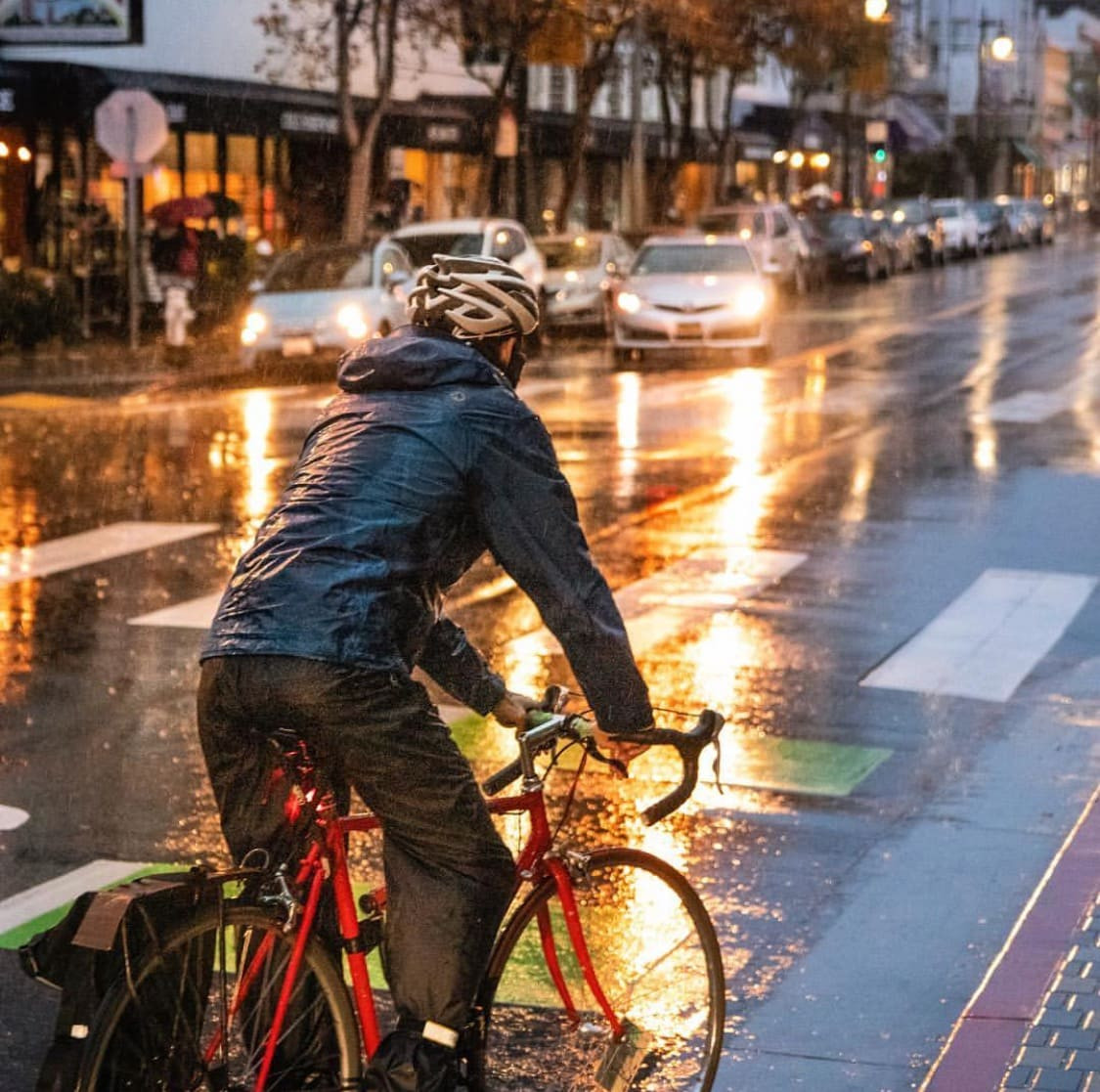 Someone on a bicycle with a downpour of rain happening around them. They are wearing full rain gear.
Someone on a bicycle with a downpour of rain happening around them. They are wearing full rain gear.
Biking in the rain can be surprisingly fun when you’re properly equipped with bike rain gear.
Before we dive into the specifics, remember the golden rule of cycling in wet conditions: ride cautiously. Wet roads can be slippery, especially painted lines and metal surfaces. Reduce your speed, increase your braking distance, and be extra aware of your surroundings. Now, let’s explore the essential bike rain gear that will keep you dry and comfortable on your rainy rides.
Bike Fenders: Your First Line of Defense Against Road Spray
Bike fenders, also known as mudguards, are arguably the most fundamental piece of bike rain gear. They act as your bicycle’s primary barrier against water and road debris kicked up by your tires. Without fenders, you’ll quickly find yourself soaked, even if the rain has stopped, thanks to lingering puddles and road spray.
Fenders prevent water from being thrown upwards and onto you, keeping your back, legs, and even your face significantly drier. They also help to keep your bike cleaner, reducing the amount of grime that accumulates on your frame and components. Choosing the right fenders can seem daunting with the variety available, but understanding your options simplifies the process.
Easy Install Clip-On Fenders: Quick and Convenient
Clip-on fenders are ideal for cyclists who need fenders only occasionally or want the flexibility to easily remove them for dry weather riding. These fenders attach without tools, often using straps or clips, making them incredibly convenient. They are a great option to keep in your bag for unexpected rain showers.
Popular clip-on fender options include SKS clip-on fenders, renowned for their ease of attachment and effectiveness. The SKS Raceblade Pro XL set offers good coverage and stays close to the wheel, while the SKS Xtra-Dry rear mudguard is a simple and effective rear fender solution.
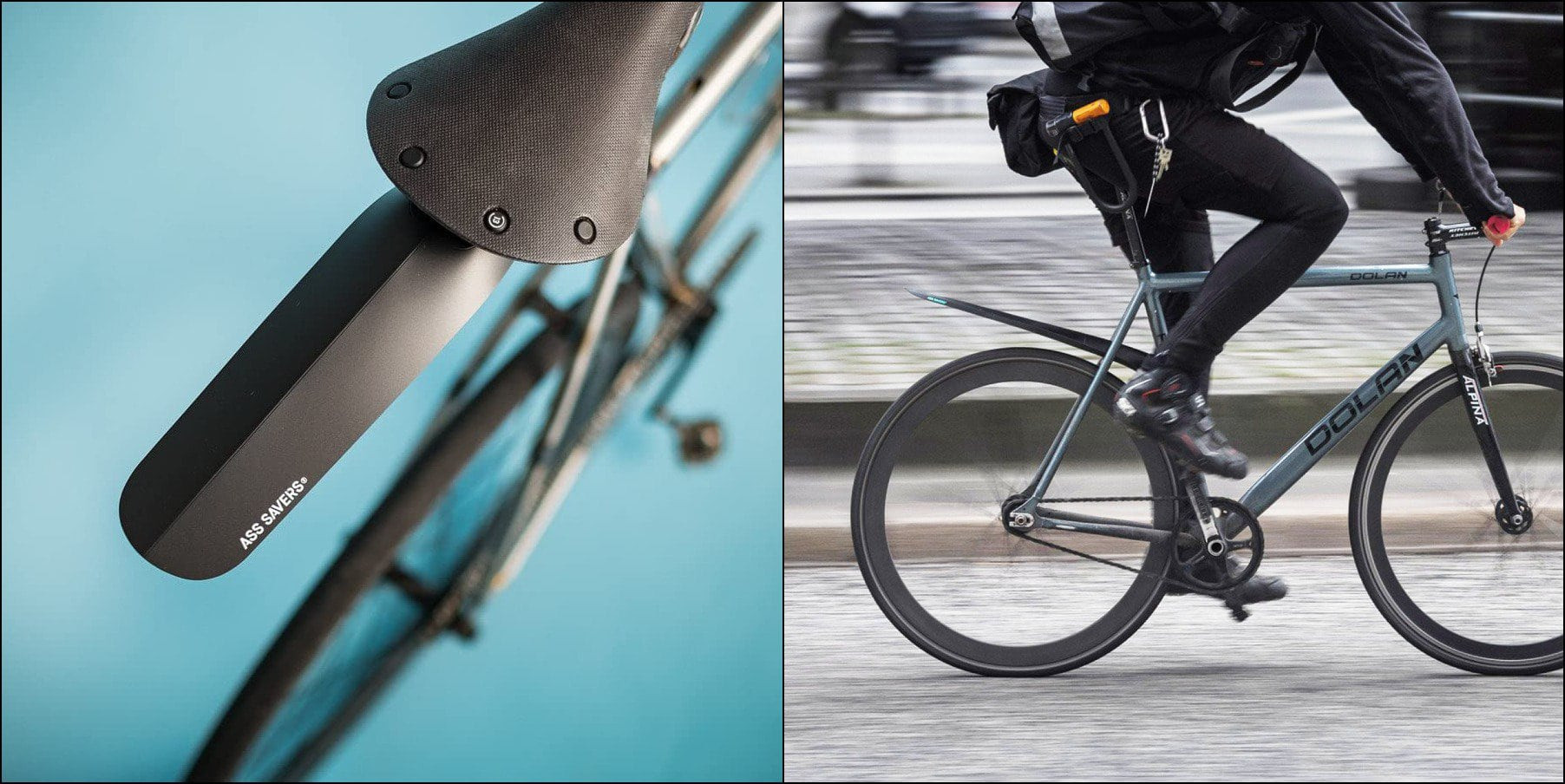 The SKS Raceblade Pro XL set on the left and the Xtra-Dry rear mudguard on the right
The SKS Raceblade Pro XL set on the left and the Xtra-Dry rear mudguard on the right
SKS Raceblade Pro XL clip-on front and rear fender set and SKS Xtra-Dry clip-on rear fender for bicycles.
For a minimalist approach, consider Ass Savers fenders. These are ultra-lightweight, foldable plastic fenders that offer basic splash protection. While not as comprehensive as full fenders, they are incredibly portable and easy to deploy when needed. The regular size Ass Saver is perfect for a quick fix, while the Ass Savers Fendor Bendor provides more extended coverage.
Permanently Attached Fenders: Reliable and Robust
Permanently attached fenders offer the most robust and reliable protection from rain and road spray. While they require a bit more effort to install initially, they provide consistent coverage and are always ready for wet conditions. These fenders are ideal for commuters and year-round cyclists who frequently encounter rain.
While specific recommendations vary depending on your bike type and tire size, brands like Planet Bike, Velo Orange, and SKS offer excellent permanently attached fender options. REI and Amazon are great resources for finding a wide selection of these fenders, often filterable by tire width to ensure a proper fit for your bike.
Detachable Fenders with Brackets: The Best of Both Worlds
Detachable fenders with brackets offer a compromise between the convenience of clip-on fenders and the robustness of permanently attached ones. They involve installing fixed brackets on your bike, allowing you to easily attach and remove the fenders as needed without tools, while providing a more secure and stable fit than simple clip-on options.
The SKS Raceblade Long is a popular example of this type of fender. It provides excellent coverage and a secure fit thanks to its bracket system, while still allowing for relatively easy removal when desired. However, ensure compatibility with your bike, especially if you have a rear rack or wider tires, as clearance can sometimes be an issue.
DIY Fenders: Creative and Cost-Effective
For the resourceful cyclist, DIY fenders can be a fun and budget-friendly solution. Fenders are essentially shaped barriers, and you can get creative with materials like plastic bottles, cardboard, or even sheet plastic. Zip ties are your best friend for attaching these DIY fenders to your bike frame.
The Ass Savers themselves are essentially intricately folded pieces of plastic, demonstrating the simplicity of the basic fender concept. Cardboard fenders, while less durable, can be a surprisingly effective temporary solution. If you experiment with DIY fenders, share your creations! A rear rack can also offer some mudguarding, but it’s usually not sufficient on its own.
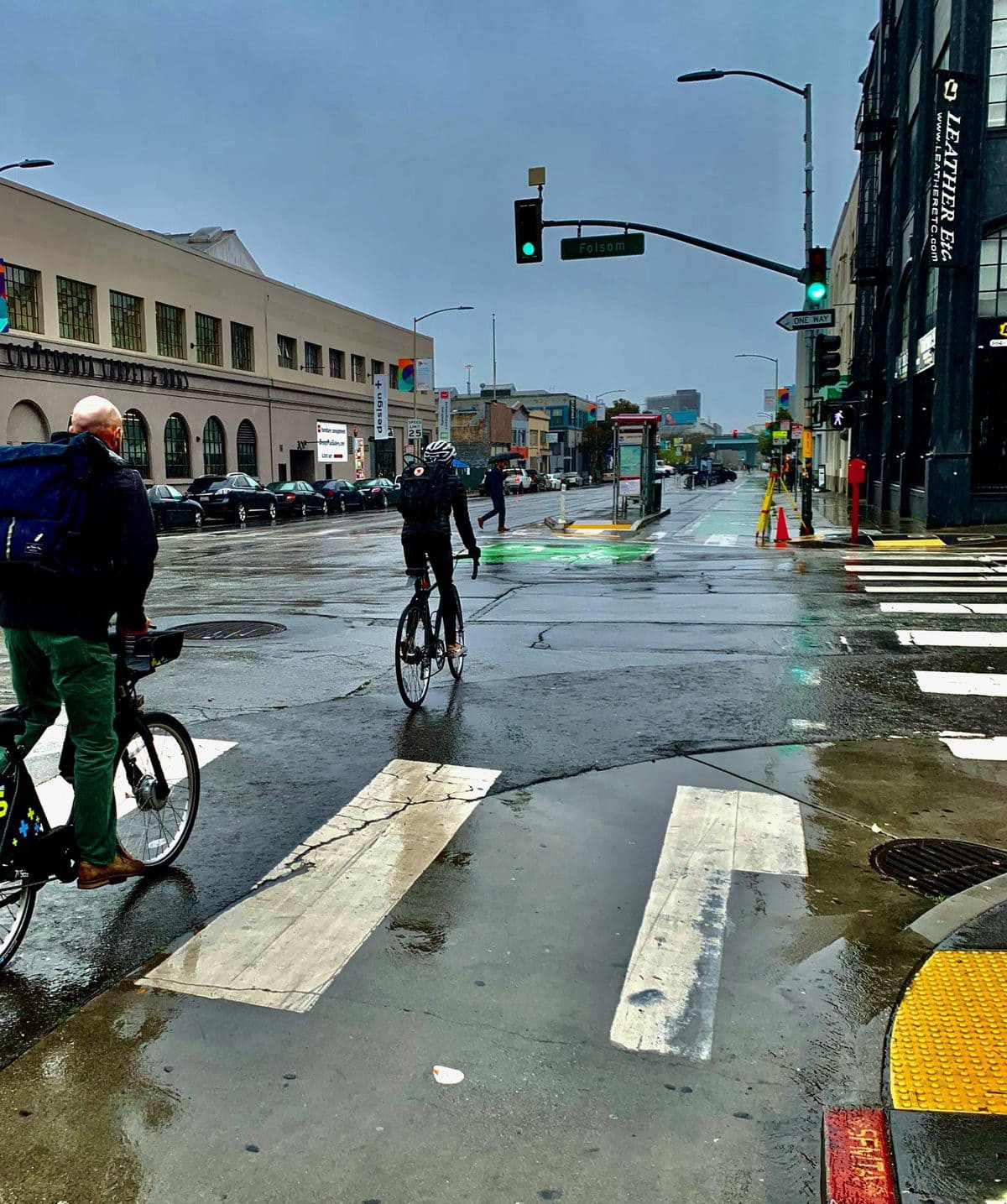 Two people riding bicycles in a protected bike lane with a cloudy gloomy sky and water on the road around them like it has just rained.
Two people riding bicycles in a protected bike lane with a cloudy gloomy sky and water on the road around them like it has just rained.
Cyclists equipped with varying levels of bike rain gear, including full fenders and minimal seat fenders, navigate a wet bike lane.
Bike Seat Cover: Protecting Your Saddle from Saturation
A bike seat cover is another valuable piece of bike rain gear, especially if you have a saddle made from water-absorbing materials. A wet saddle can be uncomfortable and lead to a soggy ride, even if you’re wearing rain pants.
Depending on your saddle material and whether you wear rain pants, a seat cover can make a significant difference in comfort. For saddles made of plastic or waterproof materials, you might be able to wipe off surface water, but absorbent saddles will retain moisture. If your bike is parked outdoors, a seat cover is essential to prevent your saddle from becoming waterlogged. A simple plastic bag can work in a pinch, or you can invest in a dedicated bike seat cover for a more durable and reliable solution.
Weather Radar App: Your Secret Weapon for Dodging Downpours
While not technically bike rain gear, a weather radar app is an invaluable tool for any cyclist venturing out in potentially wet conditions. Rain can be localized and intermittent, and a weather radar app provides real-time information on precipitation, allowing you to plan your rides to avoid the heaviest downpours or find rain-free windows.
Weather radar is far more precise than general weather forecasts, giving you a granular view of rain patterns in your area. Apps like RainViewer, MyRadar, and local weather apps with radar functionality can be lifesavers. By monitoring the radar, you can often time your rides to minimize rain exposure, even without full rain gear.
Fast Drying Normal Clothes: For Light Rain and Drizzles
For light rain or drizzles, you might be able to get away with wearing fast-drying normal clothes instead of dedicated bike rain gear. Certain fabrics dry much quicker than others, making them suitable for mild wet conditions.
Chinos dry faster than jeans, and technical hiking pants, often made from synthetic materials, can dry remarkably quickly. Fabrics like nylon, polyester, and merino wool are excellent choices for their quick-drying properties. Pair fast-drying pants with a fast-drying shirt and you can stay reasonably comfortable in light rain. However, for heavier rain, dedicated rain gear is essential.
Rain Jacket or Rain Poncho: Upper Body Protection is Key
A rain jacket is a fundamental piece of bike rain gear for protecting your upper body from rain. It provides a waterproof and windproof barrier, keeping your core dry and comfortable. Even in light rain, a rain jacket can make a significant difference.
Higher-quality rain jackets often feature breathable membranes that allow moisture vapor to escape, reducing sweat buildup inside the jacket. Look for features like zippered pockets, adjustable hoods, and reflective elements for added safety and convenience. While cheaper rain jackets can also offer basic rain protection, they may lack breathability.
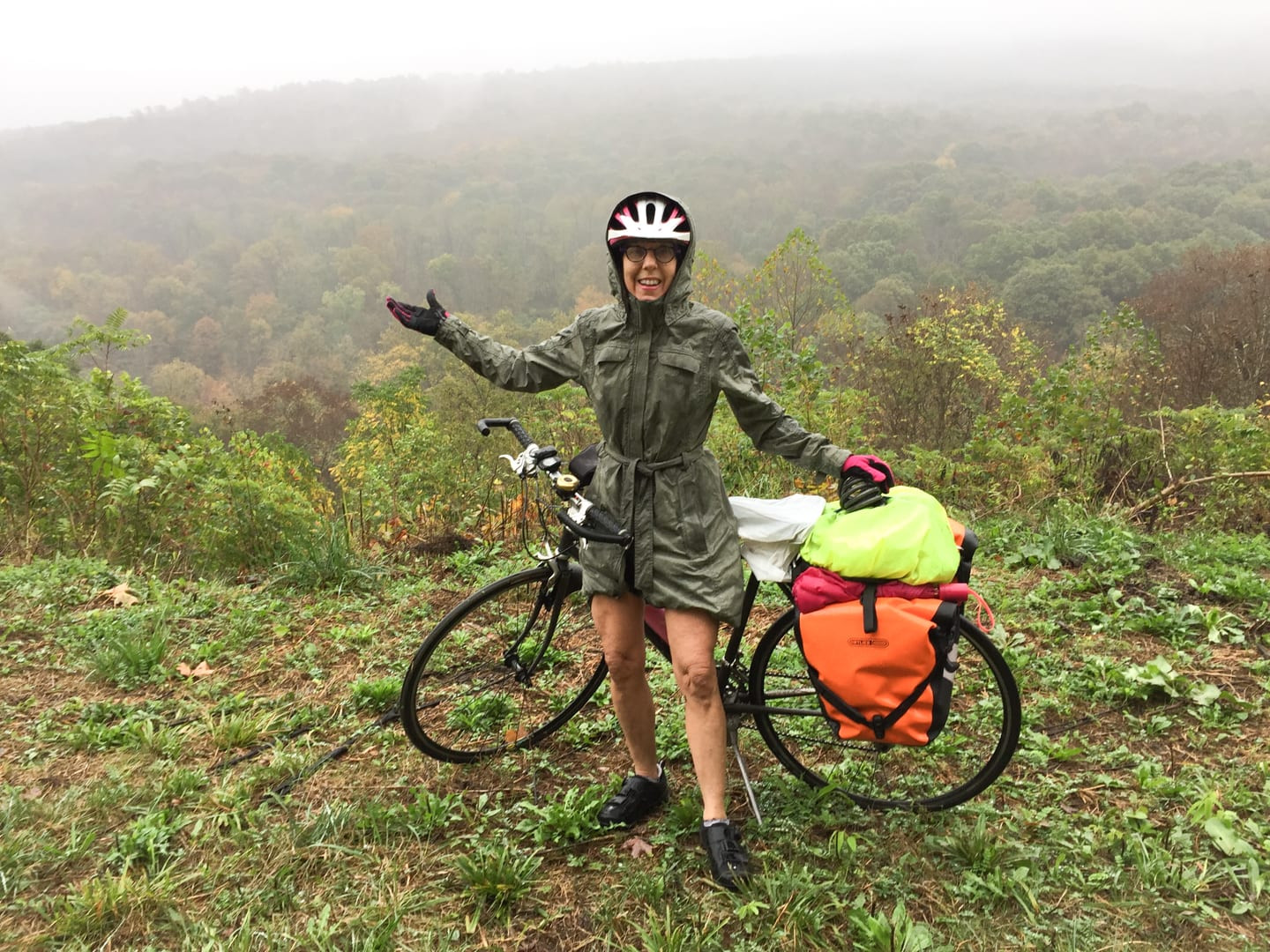 A person in a rain jacket standing next to a bicycle with all the touring gear and panniers. A beautiful foggy tree filled landscape is in the background.
A person in a rain jacket standing next to a bicycle with all the touring gear and panniers. A beautiful foggy tree filled landscape is in the background.
A cyclist prepared for rain with a long rain jacket, bike seat cover, waterproof panniers, and backpack rain cover.
Another option for upper body rain protection is a rain poncho or rain cape. Bike-specific ponchos are designed to drape over your handlebars, providing extra coverage for your legs as well as your upper body. Ponchos offer excellent ventilation, reducing the risk of overheating, but they may not provide as much leg protection as rain pants and can be less effective in windy conditions.
Rain Pants or a Rain Skirt: Leg Protection for Dry Comfort
Rain pants are a game-changer for cycling in the rain. They provide waterproof protection for your legs, keeping you dry and comfortable even in heavy rain. Combined with fenders and a rain jacket, rain pants complete your core bike rain gear setup.
Look for rain pants with features like zippered pockets for accessibility and ankle closures to prevent water from splashing up your legs. Some rain pants are designed with side slits for easy access to pockets underneath. Always use an ankle strap on your right leg to prevent your rain pants from getting caught in your bike chain, especially if you don’t have a chain guard.
If pants aren’t your preference, rain skirts or rain kilts are alternatives. Rain skirts are easier to take off over shoes than rain pants, offering convenience for quick changes.
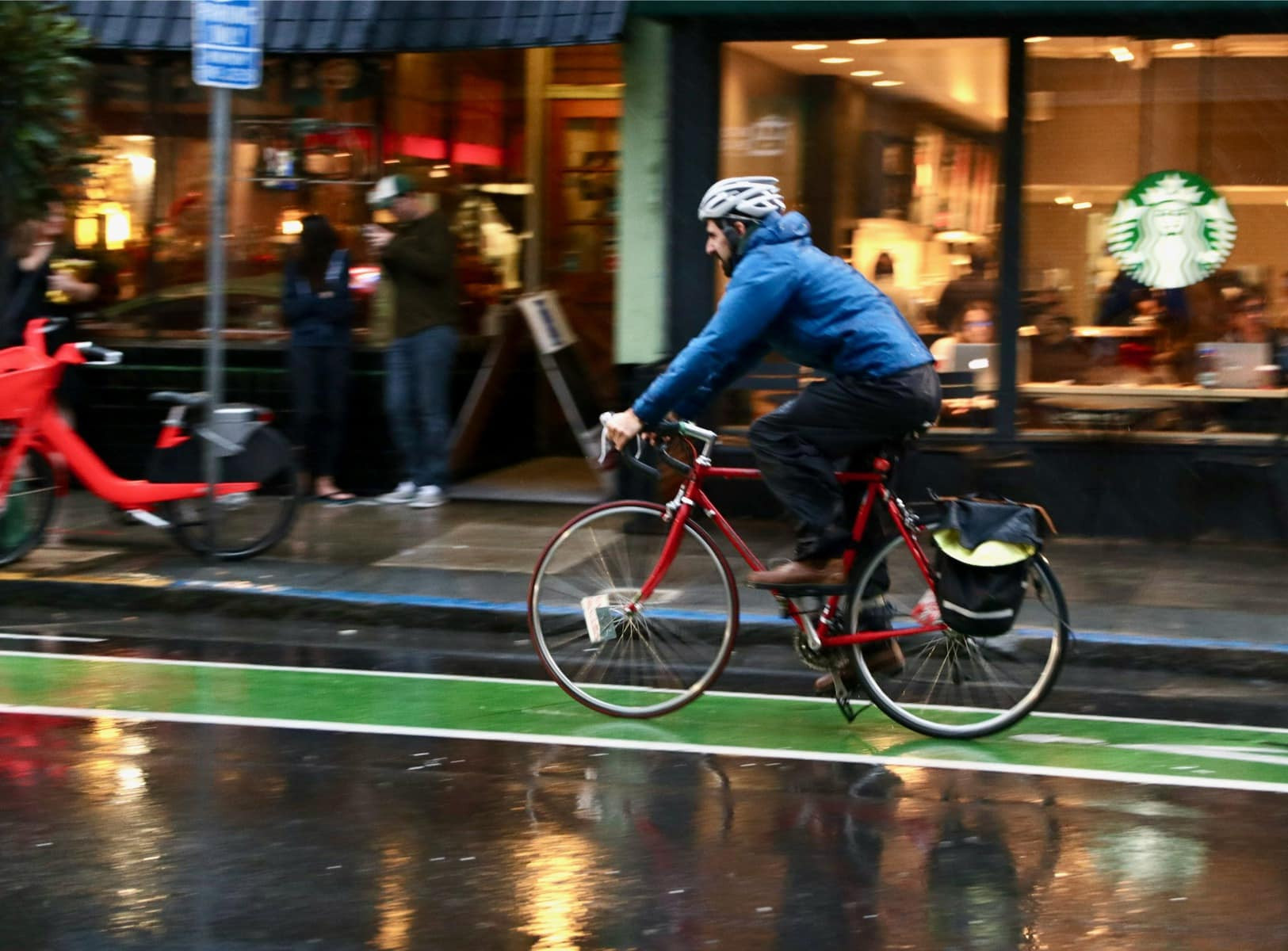 A person on a road bicycle riding in a bike lane with a wet road and a light drizzle. There
A person on a road bicycle riding in a bike lane with a wet road and a light drizzle. There
A cyclist sporting a rain jacket and rain pants, demonstrating effective bike rain gear for leg and upper body protection.
Protect Your Shoes and Socks: Keeping Your Feet Dry
Once your legs are protected with rain pants, water runoff will often flow directly into your shoes. Therefore, waterproof shoe protection becomes crucial. Wet feet are not only uncomfortable but can also lead to blisters and cold feet.
Waterproof socks provide a base layer of defense, ensuring your feet stay dry even if some water penetrates your shoes. For shoes themselves, you have two main options: waterproof shoes and shoe rain covers.
Waterproof Shoes: All-in-One Foot Protection
Waterproof shoes are the simplest solution for keeping your feet dry in the rain. They eliminate the need for extra layers or covers and are always ready for wet conditions. Waterproof hiking shoes or boots that extend to mid-ankle height offer good protection. Look for shoes with Gore-Tex or other waterproof membranes.
Brands like Blundstone offer stylish and water-resistant boots that are popular for everyday wear and light rain protection. For more serious rain, consider dedicated waterproof cycling shoes or hiking shoes with robust waterproofing.
Shoe Rain Covers or Galoshes: Versatile and Adaptable
Shoe rain covers, or galoshes, provide a versatile solution for keeping your shoes dry. They can be worn over your regular cycling shoes or everyday shoes, allowing you to maintain your preferred footwear while adding waterproof protection when needed.
Rain shoe covers are available in various styles, from basic waterproof booties to more elaborate designs that offer enhanced coverage and durability. Clear shoe covers are a fashionable option for maintaining visibility of your shoes underneath.
Keep Your Head and Face Dry: Comfort and Visibility
With your body and feet protected, attention turns to keeping your head and face dry. While some cyclists enjoy the feeling of rain on their face, others prefer to stay completely dry for comfort and to maintain clear vision.
Hair Protection: Shower Caps and Hoods
For keeping your hair dry under your helmet, a simple shower cap is surprisingly effective. It’s lightweight, inexpensive, and fits easily under your helmet without being noticeable. Alternatively, the hood of your rain jacket can also provide hair protection.
Experiment with wearing your rain jacket hood under or over your helmet to see which provides a better fit and visibility. Wearing the hood over the helmet offers easier adjustment during your ride, while wearing it underneath can provide a snugger fit and better wind resistance.
Face, Eyes, and Makeup: Visors, Glasses, and Waterproof Makeup
To shield your face and eyes from rain, a visor is highly effective. A helmet visor can offer some protection, but a baseball cap worn under your helmet provides better coverage as it sits closer to your eyes. Loosen your helmet straps slightly to accommodate a cap or hood underneath. Cycling caps with extended visors are also designed for rain protection.
Clear glasses are beneficial for keeping rain out of your eyes, but water droplets can bead up on the lenses, impairing vision. Wiping your glasses with a finger or glove can act as a temporary windshield wiper. Fogging can also be an issue with glasses in humid conditions. Anti-fog spray or contact lenses can address this problem. For makeup, waterproof options are available to withstand rainy rides.
Waterproof Gloves: Warmth and Dry Hands
Rain often comes with cooler temperatures, making waterproof gloves essential bike rain gear for hand comfort. Wet hands can quickly become cold and uncomfortable, especially when exposed to wind chill while cycling.
Leather gloves with touchscreen compatibility offer a balance of style, dexterity, and some water resistance. While not fully waterproof, they can repel light rain for a while. For guaranteed waterproofness and warmth, opt for dedicated waterproof cycling gloves.
For extreme cold and wet conditions, consider bar mitts, which attach to your handlebars and provide a sheltered space for your hands. Bar mitts offer superior protection against wind, rain, and cold, and are popular for winter cycling.
Keeping Your Things Dry: Waterproof Bike Bags and Backpack Covers
If you’re commuting or running errands by bike in the rain, you’ll need a way to keep your belongings dry. Waterproof bike bags and backpack covers are essential for protecting your gear.
Waterproof Bike Bags: Panniers and Basket Solutions
Waterproof bike panniers are ideal for carrying cargo on your bike rack in wet weather. They offer ample storage space and are designed to be completely waterproof, keeping your clothes, electronics, and other items dry. Roll-top panniers, like Ortlieb Backrollers, provide excellent water protection and are popular among commuters and tourers.
For bikes with baskets or crates, you can use a bike basket cover or a dry bag to protect your contents. A backpack rain cover can also double as a basket cover, offering a versatile solution.
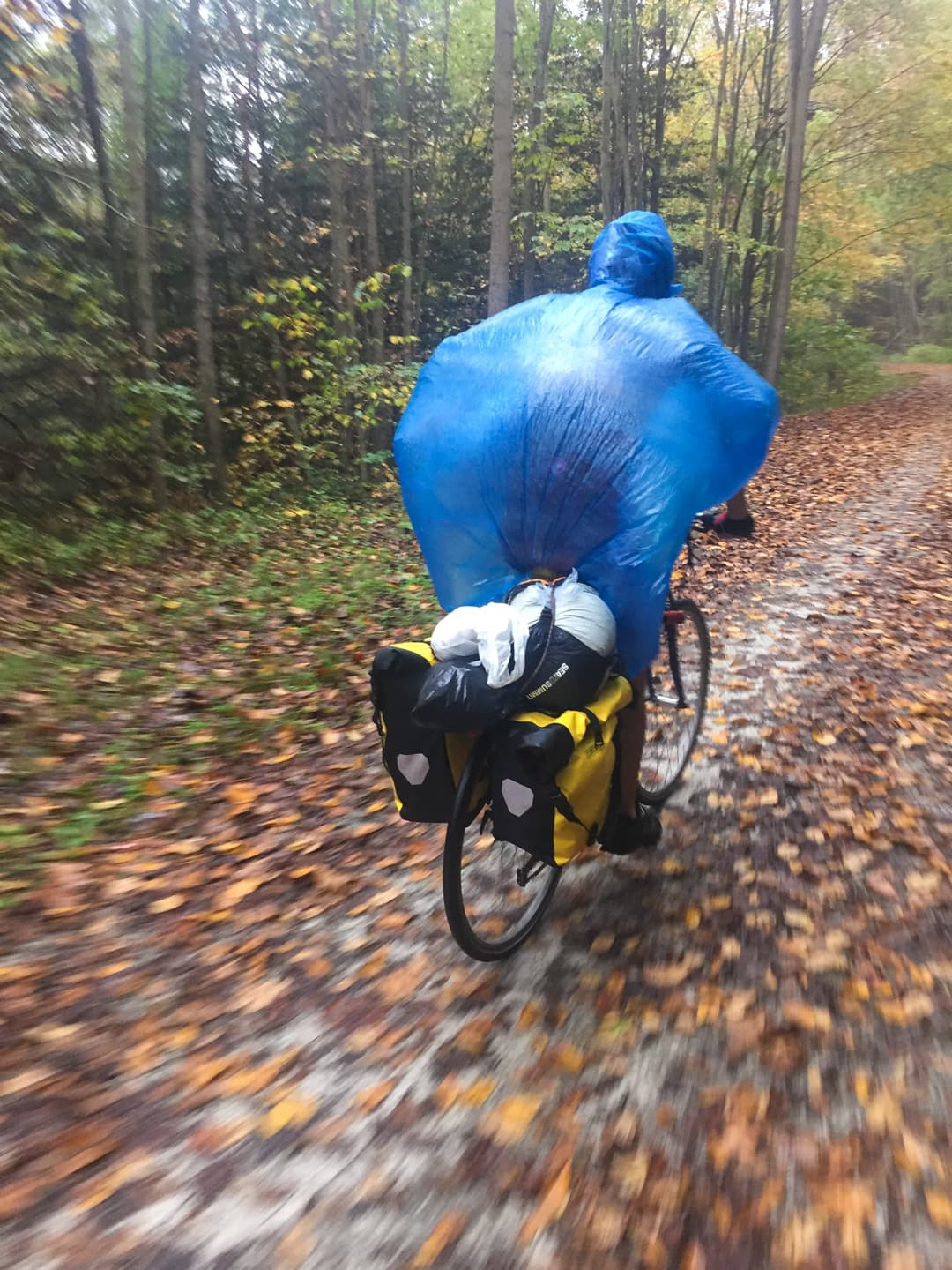 A person on a bicycle with a rain poncho billowing in the wind. The rear rack has 2 large panniers and some other things strapped on with a bungie cord.
A person on a bicycle with a rain poncho billowing in the wind. The rear rack has 2 large panniers and some other things strapped on with a bungie cord.
Waterproof Ortlieb Backroller panniers provide reliable protection for belongings during rainy bike rides.
Backpack Rain Cover: Protecting Your Backpack on the Go
For shorter commutes or casual rides, a backpack rain cover is a convenient way to protect your backpack from rain. These lightweight covers are designed to fit snugly over your backpack, providing a waterproof barrier.
If you don’t have a dedicated backpack rain cover, you can improvise by wearing your rain jacket over your backpack. While this may not provide complete coverage, it can offer sufficient protection, especially when combined with fenders to minimize road spray from behind.
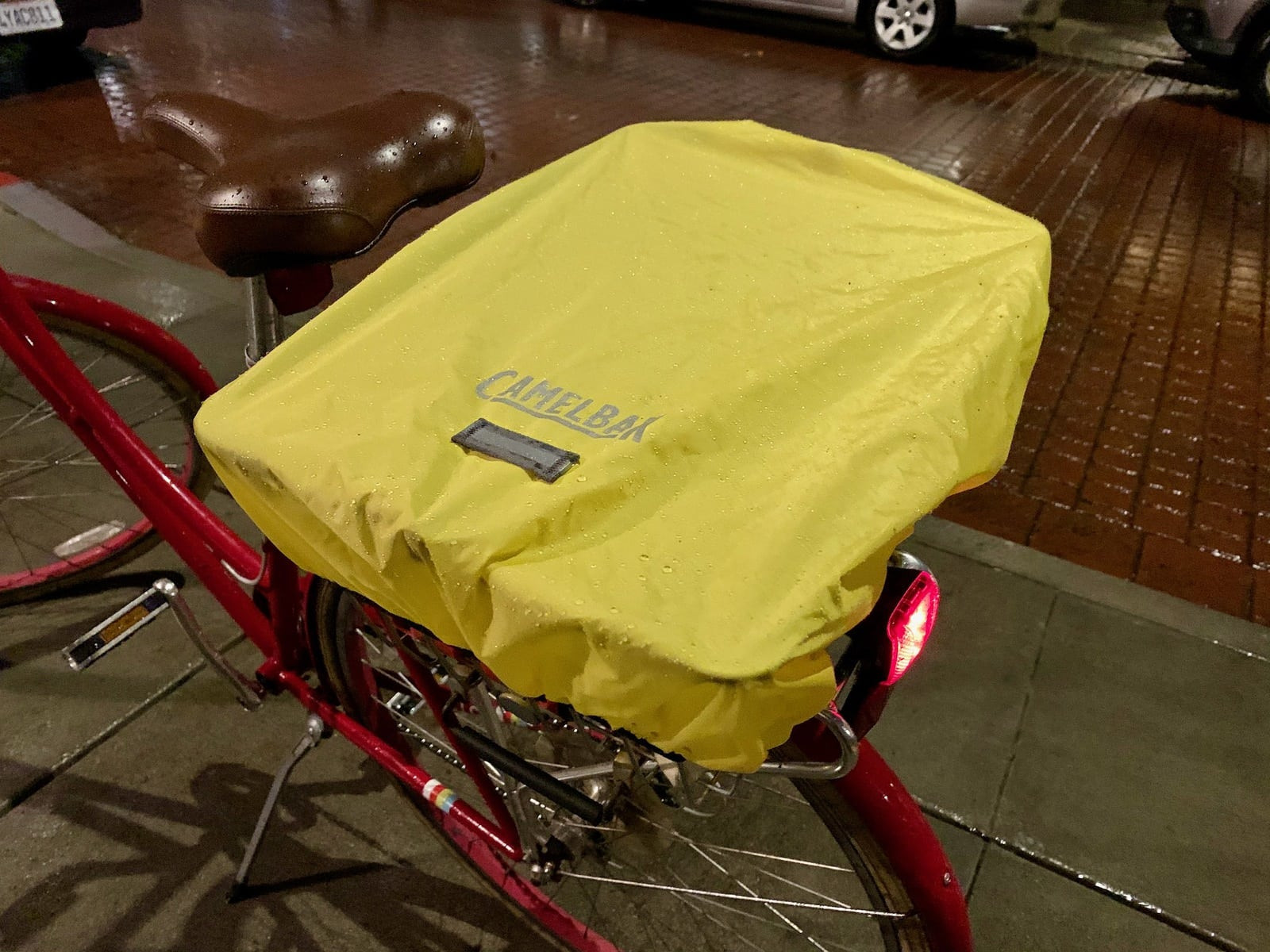 A backpack cover on a bicycle basket to protect things from the rain. There
A backpack cover on a bicycle basket to protect things from the rain. There
A backpack rain cover repurposed to protect items in a bicycle basket from rain.
(Re)Waterproof Your Rain Gear and Clothes: Maintaining Performance
Over time, the Durable Water Repellent (DWR) coating on rain gear can wear off, causing your jacket and pants to lose their waterproofness and “wet out.” Fortunately, you can restore the water repellency of your rain gear by re-waterproofing it.
Re-waterproofing involves applying a DWR product, either as a spray-on or wash-in treatment, to your rain gear. Follow the product instructions carefully for best results. Regularly re-waterproofing your rain gear will extend its lifespan and ensure it continues to perform effectively in wet conditions.
Rain, Rain, Don’t Stay Away!
With the right bike rain gear, you can confidently embrace rainy day cycling. From fenders and waterproof jackets to shoe covers and waterproof bags, there’s gear to keep every part of you and your belongings dry and comfortable. So, gear up, get out there, and rediscover the joy of cycling, rain or shine! Just remember to ride safely and enjoy the refreshing experience of a rainy bike ride.
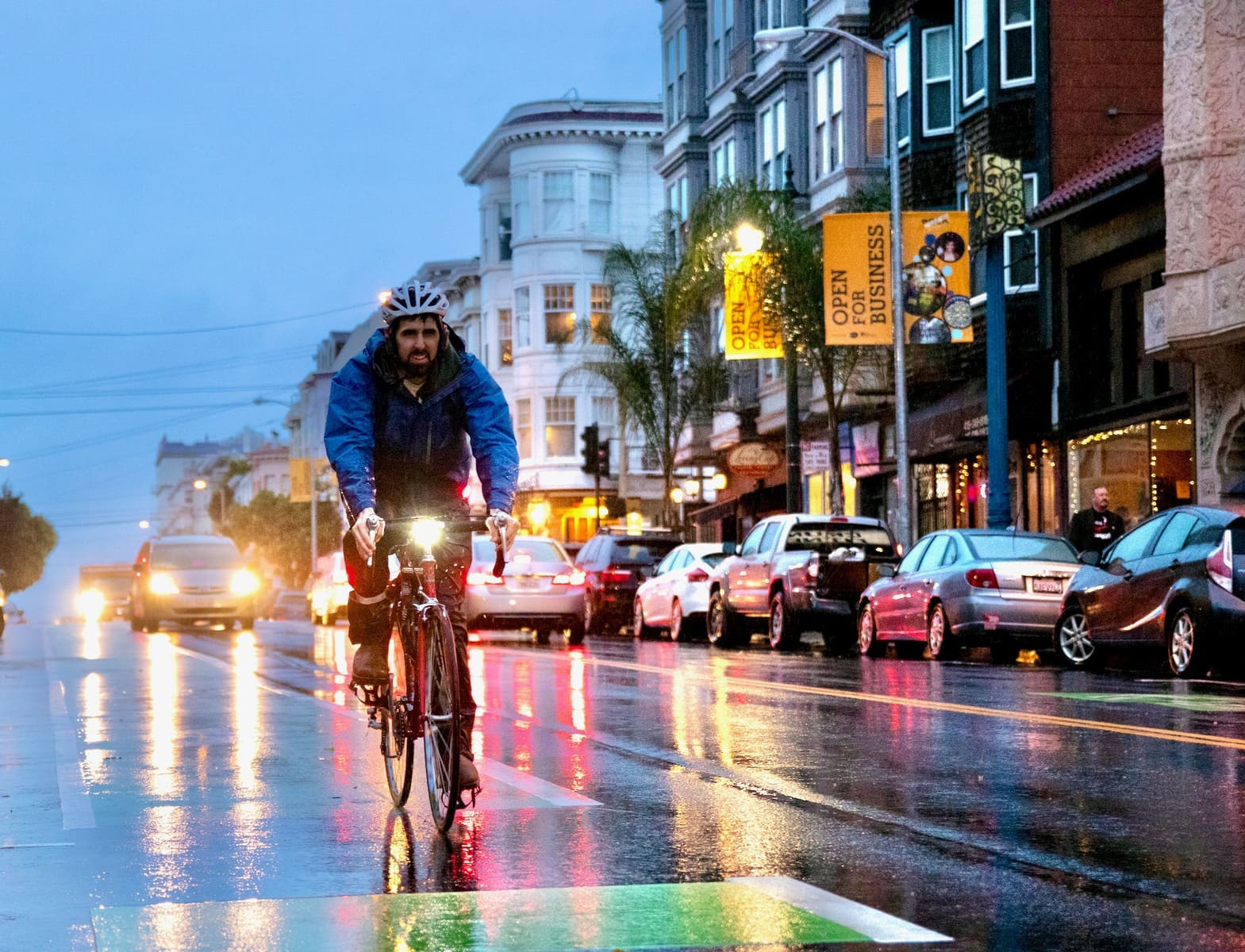 A person riding a bicycle towards the camera in a bike lane wearing full rain gear.
A person riding a bicycle towards the camera in a bike lane wearing full rain gear.
Enjoy the ride, rain or shine, with the right bike rain gear.

